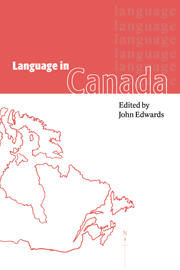Book contents
- Frontmatter
- Contents
- List of figures
- List of maps
- List of tables
- Notes on contributors
- 1 Canada
- Introduction
- 1 The foundations
- 2 The fading Canadian duality
- 3 Official bilingualism: from the 1960s to the 1990s
- 4 Official multiculturalism
- 5 Language in education: bridging educational policy and social psychological research
- 6 Aboriginal languages: history
- 7 Aboriginal languages: current status
- 8 French: Canadian varieties
- 9 French in Quebec
- 10 French in New Brunswick
- 11 French outside New Brunswick and Quebec
- 12 English: Canadian varieties
- 13 English Quebec
- 14 The teaching of international languages
- 15 French immersion in Canada
- 16 Language in Newfoundland
- 17 Language in Prince Edward Island
- 18 Language in Nova Scotia
- 19 Language in New Brunswick
- 20 Language in Quebec: aboriginal and heritage varieties
- 21 Language in Ontario
- 22 Language in Manitoba
- 23 Language in Saskatchewan: Anglo-hegemony maintained
- 24 Language in Alberta: unilingualism in practice
- 25 Language in British Columbia
- 26 Language in the Northwest Territories and the Yukon Territory
- Index of names
- Index of language families, languages, dialects
- Index of subjects
6 - Aboriginal languages: history
Published online by Cambridge University Press: 18 February 2010
- Frontmatter
- Contents
- List of figures
- List of maps
- List of tables
- Notes on contributors
- 1 Canada
- Introduction
- 1 The foundations
- 2 The fading Canadian duality
- 3 Official bilingualism: from the 1960s to the 1990s
- 4 Official multiculturalism
- 5 Language in education: bridging educational policy and social psychological research
- 6 Aboriginal languages: history
- 7 Aboriginal languages: current status
- 8 French: Canadian varieties
- 9 French in Quebec
- 10 French in New Brunswick
- 11 French outside New Brunswick and Quebec
- 12 English: Canadian varieties
- 13 English Quebec
- 14 The teaching of international languages
- 15 French immersion in Canada
- 16 Language in Newfoundland
- 17 Language in Prince Edward Island
- 18 Language in Nova Scotia
- 19 Language in New Brunswick
- 20 Language in Quebec: aboriginal and heritage varieties
- 21 Language in Ontario
- 22 Language in Manitoba
- 23 Language in Saskatchewan: Anglo-hegemony maintained
- 24 Language in Alberta: unilingualism in practice
- 25 Language in British Columbia
- 26 Language in the Northwest Territories and the Yukon Territory
- Index of names
- Index of language families, languages, dialects
- Index of subjects
Summary
INTRODUCTION
According to Bright (1994), as many as 300 aboriginal languages may have been spoken in North America, although the number has been significantly reduced since the first contact with Europeans, and many are on the verge of extinction. Canada's fifty-three aboriginal languages are classified into eleven families and isolates (Foster, 1982). Despite the genetic and typological diversity of aboriginal languages that have existed since prehistoric times, their intricate grammars and enriched vocabularies have not been recognized and appreciated for what they are by the general public. Although the situation has been changing, one often encounters people who believe that there are only two aboriginal languages, ‘Eskimo’ and ‘Indian’ and that these languages are ‘primitive’ – without an elaborate grammar or vocabulary. Needless to say, that is far from true, and such a myth is largely attributable to the lack of accessible information and inadequate documentation, even in the professional literature. This chapter, therefore, addresses an audience which is little informed of the basic facts about aboriginal languages from a historical perspective. Specifically, this chapter deals with such questions as: (a) are the indigenous languages related to those of the Old World; (b) how are they classified genetically; (c) how are they distributed; (d) how viable are they in the multilingual Canadian society?
THE ORIGIN OF THE NEW WORLD LANGUAGES
Greenberg's (1987) Language in the Americas triggered vigorous debates, mostly rejecting his claims and criticizing his cavalier method and data handling.
- Type
- Chapter
- Information
- Language in Canada , pp. 125 - 143Publisher: Cambridge University PressPrint publication year: 1998
- 1
- Cited by

